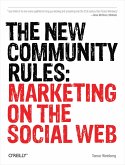Schade – dieser Artikel ist leider ausverkauft. Sobald wir wissen, ob und wann der Artikel wieder verfügbar ist, informieren wir Sie an dieser Stelle.
- Broschiertes Buch
- Merkliste
- Auf die Merkliste
- Bewerten Bewerten
- Teilen
- Produkt teilen
- Produkterinnerung
- Produkterinnerung
Building a social web application that attracts and retains regular visitors, and gets them to interact, isn't easy to do. This book walks you through the tough questions you'll face if you're to create a truly effective community site -- one that makes visitors feel like they've found a new home on the Web.Whether you're creating a new site from scratch or embracing an existing audience. Building Social Web Applications helps you and your fellow web developers, designers, and project managers make difficult decisions, such as choosing the appropriate interaction tools for your audience, and…mehr
Andere Kunden interessierten sich auch für
![The New Community Rules The New Community Rules]() Tamar WeinbergThe New Community Rules22,99 €
Tamar WeinbergThe New Community Rules22,99 €![The Internet As A Diverse Community The Internet As A Diverse Community]() Urs E GattikerThe Internet As A Diverse Community189,99 €
Urs E GattikerThe Internet As A Diverse Community189,99 €![Open Networked I-Learning Open Networked I-Learning]() Open Networked I-Learning77,99 €
Open Networked I-Learning77,99 €![Building Web Reputation Systems Building Web Reputation Systems]() F. Randall FarmerBuilding Web Reputation Systems34,99 €
F. Randall FarmerBuilding Web Reputation Systems34,99 €![Community-Built Databases Community-Built Databases]() Community-Built Databases77,99 €
Community-Built Databases77,99 €![Developing with Google+ Developing with Google+]() Jennifer MurphyDeveloping with Google+21,99 €
Jennifer MurphyDeveloping with Google+21,99 €![SpamAssassin SpamAssassin]() Alan SchwartzSpamAssassin26,99 €
Alan SchwartzSpamAssassin26,99 €
Building a social web application that attracts and retains regular visitors, and gets them to interact, isn't easy to do. This book walks you through the tough questions you'll face if you're to create a truly effective community site -- one that makes visitors feel like they've found a new home on the Web.Whether you're creating a new site from scratch or embracing an existing audience. Building Social Web Applications helps you and your fellow web developers, designers, and project managers make difficult decisions, such as choosing the appropriate interaction tools for your audience, and building an infrastructure to help the community gel. With this book, you'll learn to: Understand who will be drawn to your site, why they'll stay, and who they'll interact with. Build the software you need versus plugging in off-the-shelf apps. Create visual design that clearly communicates what your site will do Manage the identities of your visitors and determine how to manage their interaction. Watch for demand from the community to guide your choice of new functions. Plan the launch of your site and get the message out. Building Social Web Applications includes examples of different application types --member-driven, customer service-driven, contributor-driven, and more -- and discusses different business models. If your company's ready to move into the world of social web applications, this book will help you make it a reality.
Produktdetails
- Produktdetails
- Verlag: O'Reilly Media
- Seitenzahl: 432
- Erscheinungstermin: 3. November 2009
- Englisch
- Abmessung: 233mm x 179mm x 30mm
- Gewicht: 597g
- ISBN-13: 9780596518752
- ISBN-10: 0596518757
- Artikelnr.: 23607525
- Herstellerkennzeichnung
- Libri GmbH
- Europaallee 1
- 36244 Bad Hersfeld
- gpsr@libri.de
- Verlag: O'Reilly Media
- Seitenzahl: 432
- Erscheinungstermin: 3. November 2009
- Englisch
- Abmessung: 233mm x 179mm x 30mm
- Gewicht: 597g
- ISBN-13: 9780596518752
- ISBN-10: 0596518757
- Artikelnr.: 23607525
- Herstellerkennzeichnung
- Libri GmbH
- Europaallee 1
- 36244 Bad Hersfeld
- gpsr@libri.de
Gavin Bell designs social web applications for the Nature Publishing Group. He is an interaction designer, community advocate and product manager. Since the early 90s, he has been writing and designing for the web. Large scale web applications covering identity, on-demand media, geolocation and social software have been the main focus of his work at NPG and previously at the BBC. He has worked in academia, advertising, publishing and developed multimedia software. He lives in London with his wife and two sons. Find out more on his personal site gavinbell.com and his blog take one onion. Photo (c) James Duncan Davidson
Dedication
Preface
Design As the Primary Approach
Who This Book Is For
Who This Book Is Not For
What You'll Learn
How This Book Is Organized
Typographical Conventions Used in This Book
Safari® Books Online
We'd Like to Hear from You
How This Book Came About
Acknowledgments
Chapter 1: Building a Social Application
1.1 Building Applications
1.2 The Distributed Nature of Seemingly Everything
1.3 Summary
Chapter 2: Analyzing, Creating, and Managing Community Relationships
2.1 Analyzing Your Users' Relationships
2.2 Analyzing the Essence of Your Community's Needs
2.3 Summary
Chapter 3: Planning Your Initial Site
3.1 Deciding What You Need
3.2 Building a Web Application
3.3 Choosing Who You Need
3.4 Planning the Life Cycle
3.5 Communicating During Development
3.6 Managing the Development Cycle
3.7 Collecting Audience Feedback
3.8 Summary
Chapter 4: Creating a Visual Impact
4.1 Dynamic Interactions
4.2 Design First
4.3 Copywriting
4.4 Summary
Chapter 5: Working with and Consuming Media
5.1 Media Types Affect Consumption Styles
5.2 Media Evolves and Consumption Styles Change
5.3 New Services Respond to Evolving Needs
5.4 Summary
Chapter 6: Managing Change
6.1 Resistance
6.2 Internal Workflow
6.3 Community Managers
6.4 Summary
Chapter 7: Designing for People
7.1 Making Software for People
7.2 Interaction Design
7.3 Identify Needs with Personas and User-Centered Design
7.4 Common Techniques for UCD
7.5 Running Interaction Design Projects
7.6 Using Agile and UCD Methods
7.7 Beyond UCD
7.8 Learning to Love Constraints
7.9 Including You, Me, and Her Over There, Plus Him, Too
7.10 Moving Quickly from Idea to Implementation
7.11 Don't Let Your Users Drown in Activity
7.12 Implementing Search
7.13 Understanding Activity and Viewpoints
7.14 Twelve Ideas to Take Away
7.15 Summary
Chapter 8: Relationships, Responsibilities, and Privacy
8.1 We Are in a Relationship?
8.2 Personal Identity and Reputation
8.3 Handling Public, Private, and Gray Information
8.4 Privacy and Aggregate Views
8.5 See But Don't Touch: Rules for Admins
8.6 Private by Default?
8.7 Setting Exposure Levels
8.8 Managing Access for Content Reuse, Applications, and Other Developers
8.9 Summary
Chapter 9: Community Structures, Software, and Behavior
9.1 Community Structures
9.2 Supporting Social Interactions
9.3 Who Is Sharing, and Why?
9.4 How Are They Sharing?
9.5 Social Software Menagerie
9.6 Groups
9.7 Summary
Chapter 10: Social Network Patterns
10.1 Sharing Social Objects
10.2 Published Sites Expect Audiences
10.3 Deep and Broad Sharing
10.4 Capturing Intentionality
10.5 Cohesion
10.6 Filtering Lists by Popularity
10.7 Commenting, Faving, and Rating
10.8 Internal Messaging Systems
10.9 Friending Considered Harmful
10.10 Sharing Events
10.11 Summary
Chapter 11: Modeling Data and Relationships
11.1 Designing URLs
11.2 Getting to the Right URL
11.3 Permalinks
11.4 Putting Objects on the Internet
11.5 Aggregating Data to Create New Content
11.6 Exploring Groups
11.7 Making the Most of Metadata
11.8 Connecting the Relationship to the Content
11.9 Considering Time Implications
11.10 Looking Beyond the Web
11.11 Summary
Chapter 12: Managing Identities
12.1 Existing Identities
12.2 Forms of Identification
12.3 The Need for Profile Pages
12.4 Activity Pages
12.5 Invisibility and Privacy
12.6 Summary
Chapter 13: Organizing Your Site for Navigation, Search, and Activity
13.1 Understanding In-Page Navigation
13.2 Connecting People Through Content
13.3 Providing Activity Pages
13.4 Filtering Activity Lists and the Past
13.5 Who Stole My Home Page?
13.6 Providing for Site Navigation
13.7 Summary
Chapter 14: Making Connections
14.1 Choosing the Correct Relationship Model for Your Social Application
14.2 Information Brokers
14.3 Notifications and Invitations
14.4 Social Network Portability
14.5 Spamming, Antipatterns, and Phishing
14.6 Address Books, the OAuth Way
14.7 Changing Relationships over Time
14.8 Administering Groups
14.9 Summary
Chapter 15: Managing Communities
15.1 Social Behavior in the Real World
15.2 Starting Up and Managing a Community
15.3 Trolls and Other Degenerates
15.4 Separating Communities
15.5 Encouraging Good Behavior
15.6 Gaming the System
15.7 Membership by Invitation or Selection
15.8 Rewarding Good Behavior
15.9 Helping the Community Manage Itself
15.10 Balancing Anonymity and Pseudo-Anonymity
15.11 Summary
Chapter 16: Writing the Application
16.1 Small Is Good: A Reprise
16.2 How Social Applications Differ from Web Applications
16.3 Agile Methodologies
16.4 Deployment and Version Control
16.5 Infrastructure and Web Operations
16.6 Designing Social Applications
16.7 Your App Has Its Own Point of View
16.8 How Code Review Helps Reduce Problems
16.9 Beyond the Web Interface, Please
16.10 Bug Tracking and Issue Management
16.11 Rapid User Interfaces
16.12 Scaling and Messaging Architectures
16.13 Implementing Search
16.14 Identity and Management of User Data
16.15 Federation
16.16 Making Your Code Green and Fast
16.17 Building Admin Tools and Gleaning Collective Intelligence
16.18 Summary
Chapter 17: Building APIs, Integration, and the Rest of the Web
17.1 "On the Internet" Versus "In the Internet"
17.2 Making Your Place Within the Internet
17.3 Why an API?
17.4 Being Open Is Good
17.5 Arguing for Your API Internally
17.6 Implementing User Management and Open Single Sign-On
17.7 Designing an API
17.8 Comparing Social APIs
17.9 Reviewing the APIs
17.10 Managing the Developer Community
17.11 Create an API?
17.12 Summary
Chapter 18: Launching, Marketing, and Evolving Social Applications
18.1 Loving and Hating the Home Page
18.2 Financing Your Site
18.3 Marketing
18.4 Achieving and Managing Critical Mass
18.5 Evolving Your Site
18.6 Establishing the Rhythm of Your Evolving Application
18.7 Summary
Colophon
Preface
Design As the Primary Approach
Who This Book Is For
Who This Book Is Not For
What You'll Learn
How This Book Is Organized
Typographical Conventions Used in This Book
Safari® Books Online
We'd Like to Hear from You
How This Book Came About
Acknowledgments
Chapter 1: Building a Social Application
1.1 Building Applications
1.2 The Distributed Nature of Seemingly Everything
1.3 Summary
Chapter 2: Analyzing, Creating, and Managing Community Relationships
2.1 Analyzing Your Users' Relationships
2.2 Analyzing the Essence of Your Community's Needs
2.3 Summary
Chapter 3: Planning Your Initial Site
3.1 Deciding What You Need
3.2 Building a Web Application
3.3 Choosing Who You Need
3.4 Planning the Life Cycle
3.5 Communicating During Development
3.6 Managing the Development Cycle
3.7 Collecting Audience Feedback
3.8 Summary
Chapter 4: Creating a Visual Impact
4.1 Dynamic Interactions
4.2 Design First
4.3 Copywriting
4.4 Summary
Chapter 5: Working with and Consuming Media
5.1 Media Types Affect Consumption Styles
5.2 Media Evolves and Consumption Styles Change
5.3 New Services Respond to Evolving Needs
5.4 Summary
Chapter 6: Managing Change
6.1 Resistance
6.2 Internal Workflow
6.3 Community Managers
6.4 Summary
Chapter 7: Designing for People
7.1 Making Software for People
7.2 Interaction Design
7.3 Identify Needs with Personas and User-Centered Design
7.4 Common Techniques for UCD
7.5 Running Interaction Design Projects
7.6 Using Agile and UCD Methods
7.7 Beyond UCD
7.8 Learning to Love Constraints
7.9 Including You, Me, and Her Over There, Plus Him, Too
7.10 Moving Quickly from Idea to Implementation
7.11 Don't Let Your Users Drown in Activity
7.12 Implementing Search
7.13 Understanding Activity and Viewpoints
7.14 Twelve Ideas to Take Away
7.15 Summary
Chapter 8: Relationships, Responsibilities, and Privacy
8.1 We Are in a Relationship?
8.2 Personal Identity and Reputation
8.3 Handling Public, Private, and Gray Information
8.4 Privacy and Aggregate Views
8.5 See But Don't Touch: Rules for Admins
8.6 Private by Default?
8.7 Setting Exposure Levels
8.8 Managing Access for Content Reuse, Applications, and Other Developers
8.9 Summary
Chapter 9: Community Structures, Software, and Behavior
9.1 Community Structures
9.2 Supporting Social Interactions
9.3 Who Is Sharing, and Why?
9.4 How Are They Sharing?
9.5 Social Software Menagerie
9.6 Groups
9.7 Summary
Chapter 10: Social Network Patterns
10.1 Sharing Social Objects
10.2 Published Sites Expect Audiences
10.3 Deep and Broad Sharing
10.4 Capturing Intentionality
10.5 Cohesion
10.6 Filtering Lists by Popularity
10.7 Commenting, Faving, and Rating
10.8 Internal Messaging Systems
10.9 Friending Considered Harmful
10.10 Sharing Events
10.11 Summary
Chapter 11: Modeling Data and Relationships
11.1 Designing URLs
11.2 Getting to the Right URL
11.3 Permalinks
11.4 Putting Objects on the Internet
11.5 Aggregating Data to Create New Content
11.6 Exploring Groups
11.7 Making the Most of Metadata
11.8 Connecting the Relationship to the Content
11.9 Considering Time Implications
11.10 Looking Beyond the Web
11.11 Summary
Chapter 12: Managing Identities
12.1 Existing Identities
12.2 Forms of Identification
12.3 The Need for Profile Pages
12.4 Activity Pages
12.5 Invisibility and Privacy
12.6 Summary
Chapter 13: Organizing Your Site for Navigation, Search, and Activity
13.1 Understanding In-Page Navigation
13.2 Connecting People Through Content
13.3 Providing Activity Pages
13.4 Filtering Activity Lists and the Past
13.5 Who Stole My Home Page?
13.6 Providing for Site Navigation
13.7 Summary
Chapter 14: Making Connections
14.1 Choosing the Correct Relationship Model for Your Social Application
14.2 Information Brokers
14.3 Notifications and Invitations
14.4 Social Network Portability
14.5 Spamming, Antipatterns, and Phishing
14.6 Address Books, the OAuth Way
14.7 Changing Relationships over Time
14.8 Administering Groups
14.9 Summary
Chapter 15: Managing Communities
15.1 Social Behavior in the Real World
15.2 Starting Up and Managing a Community
15.3 Trolls and Other Degenerates
15.4 Separating Communities
15.5 Encouraging Good Behavior
15.6 Gaming the System
15.7 Membership by Invitation or Selection
15.8 Rewarding Good Behavior
15.9 Helping the Community Manage Itself
15.10 Balancing Anonymity and Pseudo-Anonymity
15.11 Summary
Chapter 16: Writing the Application
16.1 Small Is Good: A Reprise
16.2 How Social Applications Differ from Web Applications
16.3 Agile Methodologies
16.4 Deployment and Version Control
16.5 Infrastructure and Web Operations
16.6 Designing Social Applications
16.7 Your App Has Its Own Point of View
16.8 How Code Review Helps Reduce Problems
16.9 Beyond the Web Interface, Please
16.10 Bug Tracking and Issue Management
16.11 Rapid User Interfaces
16.12 Scaling and Messaging Architectures
16.13 Implementing Search
16.14 Identity and Management of User Data
16.15 Federation
16.16 Making Your Code Green and Fast
16.17 Building Admin Tools and Gleaning Collective Intelligence
16.18 Summary
Chapter 17: Building APIs, Integration, and the Rest of the Web
17.1 "On the Internet" Versus "In the Internet"
17.2 Making Your Place Within the Internet
17.3 Why an API?
17.4 Being Open Is Good
17.5 Arguing for Your API Internally
17.6 Implementing User Management and Open Single Sign-On
17.7 Designing an API
17.8 Comparing Social APIs
17.9 Reviewing the APIs
17.10 Managing the Developer Community
17.11 Create an API?
17.12 Summary
Chapter 18: Launching, Marketing, and Evolving Social Applications
18.1 Loving and Hating the Home Page
18.2 Financing Your Site
18.3 Marketing
18.4 Achieving and Managing Critical Mass
18.5 Evolving Your Site
18.6 Establishing the Rhythm of Your Evolving Application
18.7 Summary
Colophon
Dedication
Preface
Design As the Primary Approach
Who This Book Is For
Who This Book Is Not For
What You'll Learn
How This Book Is Organized
Typographical Conventions Used in This Book
Safari® Books Online
We'd Like to Hear from You
How This Book Came About
Acknowledgments
Chapter 1: Building a Social Application
1.1 Building Applications
1.2 The Distributed Nature of Seemingly Everything
1.3 Summary
Chapter 2: Analyzing, Creating, and Managing Community Relationships
2.1 Analyzing Your Users' Relationships
2.2 Analyzing the Essence of Your Community's Needs
2.3 Summary
Chapter 3: Planning Your Initial Site
3.1 Deciding What You Need
3.2 Building a Web Application
3.3 Choosing Who You Need
3.4 Planning the Life Cycle
3.5 Communicating During Development
3.6 Managing the Development Cycle
3.7 Collecting Audience Feedback
3.8 Summary
Chapter 4: Creating a Visual Impact
4.1 Dynamic Interactions
4.2 Design First
4.3 Copywriting
4.4 Summary
Chapter 5: Working with and Consuming Media
5.1 Media Types Affect Consumption Styles
5.2 Media Evolves and Consumption Styles Change
5.3 New Services Respond to Evolving Needs
5.4 Summary
Chapter 6: Managing Change
6.1 Resistance
6.2 Internal Workflow
6.3 Community Managers
6.4 Summary
Chapter 7: Designing for People
7.1 Making Software for People
7.2 Interaction Design
7.3 Identify Needs with Personas and User-Centered Design
7.4 Common Techniques for UCD
7.5 Running Interaction Design Projects
7.6 Using Agile and UCD Methods
7.7 Beyond UCD
7.8 Learning to Love Constraints
7.9 Including You, Me, and Her Over There, Plus Him, Too
7.10 Moving Quickly from Idea to Implementation
7.11 Don't Let Your Users Drown in Activity
7.12 Implementing Search
7.13 Understanding Activity and Viewpoints
7.14 Twelve Ideas to Take Away
7.15 Summary
Chapter 8: Relationships, Responsibilities, and Privacy
8.1 We Are in a Relationship?
8.2 Personal Identity and Reputation
8.3 Handling Public, Private, and Gray Information
8.4 Privacy and Aggregate Views
8.5 See But Don't Touch: Rules for Admins
8.6 Private by Default?
8.7 Setting Exposure Levels
8.8 Managing Access for Content Reuse, Applications, and Other Developers
8.9 Summary
Chapter 9: Community Structures, Software, and Behavior
9.1 Community Structures
9.2 Supporting Social Interactions
9.3 Who Is Sharing, and Why?
9.4 How Are They Sharing?
9.5 Social Software Menagerie
9.6 Groups
9.7 Summary
Chapter 10: Social Network Patterns
10.1 Sharing Social Objects
10.2 Published Sites Expect Audiences
10.3 Deep and Broad Sharing
10.4 Capturing Intentionality
10.5 Cohesion
10.6 Filtering Lists by Popularity
10.7 Commenting, Faving, and Rating
10.8 Internal Messaging Systems
10.9 Friending Considered Harmful
10.10 Sharing Events
10.11 Summary
Chapter 11: Modeling Data and Relationships
11.1 Designing URLs
11.2 Getting to the Right URL
11.3 Permalinks
11.4 Putting Objects on the Internet
11.5 Aggregating Data to Create New Content
11.6 Exploring Groups
11.7 Making the Most of Metadata
11.8 Connecting the Relationship to the Content
11.9 Considering Time Implications
11.10 Looking Beyond the Web
11.11 Summary
Chapter 12: Managing Identities
12.1 Existing Identities
12.2 Forms of Identification
12.3 The Need for Profile Pages
12.4 Activity Pages
12.5 Invisibility and Privacy
12.6 Summary
Chapter 13: Organizing Your Site for Navigation, Search, and Activity
13.1 Understanding In-Page Navigation
13.2 Connecting People Through Content
13.3 Providing Activity Pages
13.4 Filtering Activity Lists and the Past
13.5 Who Stole My Home Page?
13.6 Providing for Site Navigation
13.7 Summary
Chapter 14: Making Connections
14.1 Choosing the Correct Relationship Model for Your Social Application
14.2 Information Brokers
14.3 Notifications and Invitations
14.4 Social Network Portability
14.5 Spamming, Antipatterns, and Phishing
14.6 Address Books, the OAuth Way
14.7 Changing Relationships over Time
14.8 Administering Groups
14.9 Summary
Chapter 15: Managing Communities
15.1 Social Behavior in the Real World
15.2 Starting Up and Managing a Community
15.3 Trolls and Other Degenerates
15.4 Separating Communities
15.5 Encouraging Good Behavior
15.6 Gaming the System
15.7 Membership by Invitation or Selection
15.8 Rewarding Good Behavior
15.9 Helping the Community Manage Itself
15.10 Balancing Anonymity and Pseudo-Anonymity
15.11 Summary
Chapter 16: Writing the Application
16.1 Small Is Good: A Reprise
16.2 How Social Applications Differ from Web Applications
16.3 Agile Methodologies
16.4 Deployment and Version Control
16.5 Infrastructure and Web Operations
16.6 Designing Social Applications
16.7 Your App Has Its Own Point of View
16.8 How Code Review Helps Reduce Problems
16.9 Beyond the Web Interface, Please
16.10 Bug Tracking and Issue Management
16.11 Rapid User Interfaces
16.12 Scaling and Messaging Architectures
16.13 Implementing Search
16.14 Identity and Management of User Data
16.15 Federation
16.16 Making Your Code Green and Fast
16.17 Building Admin Tools and Gleaning Collective Intelligence
16.18 Summary
Chapter 17: Building APIs, Integration, and the Rest of the Web
17.1 "On the Internet" Versus "In the Internet"
17.2 Making Your Place Within the Internet
17.3 Why an API?
17.4 Being Open Is Good
17.5 Arguing for Your API Internally
17.6 Implementing User Management and Open Single Sign-On
17.7 Designing an API
17.8 Comparing Social APIs
17.9 Reviewing the APIs
17.10 Managing the Developer Community
17.11 Create an API?
17.12 Summary
Chapter 18: Launching, Marketing, and Evolving Social Applications
18.1 Loving and Hating the Home Page
18.2 Financing Your Site
18.3 Marketing
18.4 Achieving and Managing Critical Mass
18.5 Evolving Your Site
18.6 Establishing the Rhythm of Your Evolving Application
18.7 Summary
Colophon
Preface
Design As the Primary Approach
Who This Book Is For
Who This Book Is Not For
What You'll Learn
How This Book Is Organized
Typographical Conventions Used in This Book
Safari® Books Online
We'd Like to Hear from You
How This Book Came About
Acknowledgments
Chapter 1: Building a Social Application
1.1 Building Applications
1.2 The Distributed Nature of Seemingly Everything
1.3 Summary
Chapter 2: Analyzing, Creating, and Managing Community Relationships
2.1 Analyzing Your Users' Relationships
2.2 Analyzing the Essence of Your Community's Needs
2.3 Summary
Chapter 3: Planning Your Initial Site
3.1 Deciding What You Need
3.2 Building a Web Application
3.3 Choosing Who You Need
3.4 Planning the Life Cycle
3.5 Communicating During Development
3.6 Managing the Development Cycle
3.7 Collecting Audience Feedback
3.8 Summary
Chapter 4: Creating a Visual Impact
4.1 Dynamic Interactions
4.2 Design First
4.3 Copywriting
4.4 Summary
Chapter 5: Working with and Consuming Media
5.1 Media Types Affect Consumption Styles
5.2 Media Evolves and Consumption Styles Change
5.3 New Services Respond to Evolving Needs
5.4 Summary
Chapter 6: Managing Change
6.1 Resistance
6.2 Internal Workflow
6.3 Community Managers
6.4 Summary
Chapter 7: Designing for People
7.1 Making Software for People
7.2 Interaction Design
7.3 Identify Needs with Personas and User-Centered Design
7.4 Common Techniques for UCD
7.5 Running Interaction Design Projects
7.6 Using Agile and UCD Methods
7.7 Beyond UCD
7.8 Learning to Love Constraints
7.9 Including You, Me, and Her Over There, Plus Him, Too
7.10 Moving Quickly from Idea to Implementation
7.11 Don't Let Your Users Drown in Activity
7.12 Implementing Search
7.13 Understanding Activity and Viewpoints
7.14 Twelve Ideas to Take Away
7.15 Summary
Chapter 8: Relationships, Responsibilities, and Privacy
8.1 We Are in a Relationship?
8.2 Personal Identity and Reputation
8.3 Handling Public, Private, and Gray Information
8.4 Privacy and Aggregate Views
8.5 See But Don't Touch: Rules for Admins
8.6 Private by Default?
8.7 Setting Exposure Levels
8.8 Managing Access for Content Reuse, Applications, and Other Developers
8.9 Summary
Chapter 9: Community Structures, Software, and Behavior
9.1 Community Structures
9.2 Supporting Social Interactions
9.3 Who Is Sharing, and Why?
9.4 How Are They Sharing?
9.5 Social Software Menagerie
9.6 Groups
9.7 Summary
Chapter 10: Social Network Patterns
10.1 Sharing Social Objects
10.2 Published Sites Expect Audiences
10.3 Deep and Broad Sharing
10.4 Capturing Intentionality
10.5 Cohesion
10.6 Filtering Lists by Popularity
10.7 Commenting, Faving, and Rating
10.8 Internal Messaging Systems
10.9 Friending Considered Harmful
10.10 Sharing Events
10.11 Summary
Chapter 11: Modeling Data and Relationships
11.1 Designing URLs
11.2 Getting to the Right URL
11.3 Permalinks
11.4 Putting Objects on the Internet
11.5 Aggregating Data to Create New Content
11.6 Exploring Groups
11.7 Making the Most of Metadata
11.8 Connecting the Relationship to the Content
11.9 Considering Time Implications
11.10 Looking Beyond the Web
11.11 Summary
Chapter 12: Managing Identities
12.1 Existing Identities
12.2 Forms of Identification
12.3 The Need for Profile Pages
12.4 Activity Pages
12.5 Invisibility and Privacy
12.6 Summary
Chapter 13: Organizing Your Site for Navigation, Search, and Activity
13.1 Understanding In-Page Navigation
13.2 Connecting People Through Content
13.3 Providing Activity Pages
13.4 Filtering Activity Lists and the Past
13.5 Who Stole My Home Page?
13.6 Providing for Site Navigation
13.7 Summary
Chapter 14: Making Connections
14.1 Choosing the Correct Relationship Model for Your Social Application
14.2 Information Brokers
14.3 Notifications and Invitations
14.4 Social Network Portability
14.5 Spamming, Antipatterns, and Phishing
14.6 Address Books, the OAuth Way
14.7 Changing Relationships over Time
14.8 Administering Groups
14.9 Summary
Chapter 15: Managing Communities
15.1 Social Behavior in the Real World
15.2 Starting Up and Managing a Community
15.3 Trolls and Other Degenerates
15.4 Separating Communities
15.5 Encouraging Good Behavior
15.6 Gaming the System
15.7 Membership by Invitation or Selection
15.8 Rewarding Good Behavior
15.9 Helping the Community Manage Itself
15.10 Balancing Anonymity and Pseudo-Anonymity
15.11 Summary
Chapter 16: Writing the Application
16.1 Small Is Good: A Reprise
16.2 How Social Applications Differ from Web Applications
16.3 Agile Methodologies
16.4 Deployment and Version Control
16.5 Infrastructure and Web Operations
16.6 Designing Social Applications
16.7 Your App Has Its Own Point of View
16.8 How Code Review Helps Reduce Problems
16.9 Beyond the Web Interface, Please
16.10 Bug Tracking and Issue Management
16.11 Rapid User Interfaces
16.12 Scaling and Messaging Architectures
16.13 Implementing Search
16.14 Identity and Management of User Data
16.15 Federation
16.16 Making Your Code Green and Fast
16.17 Building Admin Tools and Gleaning Collective Intelligence
16.18 Summary
Chapter 17: Building APIs, Integration, and the Rest of the Web
17.1 "On the Internet" Versus "In the Internet"
17.2 Making Your Place Within the Internet
17.3 Why an API?
17.4 Being Open Is Good
17.5 Arguing for Your API Internally
17.6 Implementing User Management and Open Single Sign-On
17.7 Designing an API
17.8 Comparing Social APIs
17.9 Reviewing the APIs
17.10 Managing the Developer Community
17.11 Create an API?
17.12 Summary
Chapter 18: Launching, Marketing, and Evolving Social Applications
18.1 Loving and Hating the Home Page
18.2 Financing Your Site
18.3 Marketing
18.4 Achieving and Managing Critical Mass
18.5 Evolving Your Site
18.6 Establishing the Rhythm of Your Evolving Application
18.7 Summary
Colophon








